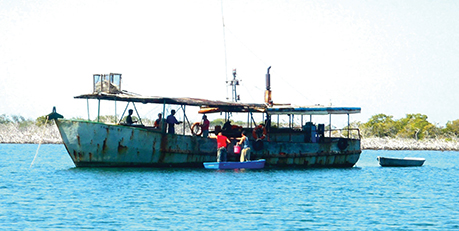Six hundred miles long, with 2,000 miles of coastline, Cuba dominates the Caribbean from Hispaniola to Yucatan. Her labyrinthine south side can be as complicated to navigate as her cruising regulations, but, as they say in Spanish, vale la pena. It’s worth the trouble. Part 2. (published August 2015)
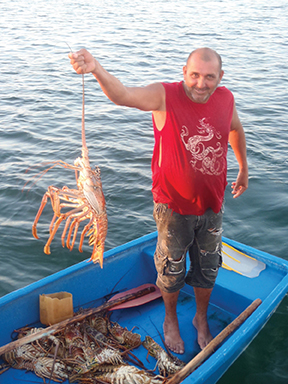 We were 200 miles west of Santiago de Cuba and 200 miles east of Cienfuegos with a norther coming. Our best course was to make for the Ana Maria Gulf. The Gulf’s mesmerizingly clear, shallow water covered a plateau that spanned most of Cuba’s southern coast. Offshore, the Cayman Trench was so deep that we barely noticed crossing an escarpment mere thousands of feet high. Then, one minute we were in 3,000 feet; the next, 300; a few minutes later, 30. Then came single digits and a color change that sent the watch scrambling to the bow to look for coral.
We were 200 miles west of Santiago de Cuba and 200 miles east of Cienfuegos with a norther coming. Our best course was to make for the Ana Maria Gulf. The Gulf’s mesmerizingly clear, shallow water covered a plateau that spanned most of Cuba’s southern coast. Offshore, the Cayman Trench was so deep that we barely noticed crossing an escarpment mere thousands of feet high. Then, one minute we were in 3,000 feet; the next, 300; a few minutes later, 30. Then came single digits and a color change that sent the watch scrambling to the bow to look for coral.
We found excellent shelter at Cayo Algodón Grande, but it had been days since we had working internet. Our cruising guide mentioned a floating hotel just south of us, in the Jardines de la Reina national marine park, that was rumored to have Wi-Fi. A few hours later we were aground in the Jardines at Avalon Tortuga. We had learned the hard way that our charts were based on mean water—not mean low water—and from then on mentally adjusted depths by two feet.
Avalon was a Cuban-Italian diving-and-fishing operation that featured two liveaboard dive boats and an oil platform repurposed into a floating hotel. The archipelago’s pristine reefs had been called incomparable by the fortunate few who had seen them. The only foreigners there were either Avalon’s clients or cruisers; only Cubans were allowed to work for Avalon.
Sergio, the diver-in-charge, greeted us in effusive English. Like other Cubans, he seemed happy about the prospect of more American tourists. “You are a pioneer! The first American boat to visit Avalon.”
That welcome left me feeling small when I asked about Wi-Fi. Wi-Fi 50 miles from the ‘mainland’ Cuba might be available, he told us, though payment wasn’t possible.
“The hotel and diving operations are strictly all-inclusive, pre-paid packages. We have no way to charge for even a mojito. And the clientèle come here expecting privacy.”
He said it without apology or irony, in the pleasant, matter-of-fact way that Cubans explained rules. Sometimes you simply had to escape the paparazzi. What better place than Socialist Cuba? If we were discreet, waiting until the esteemed guests left on a dive, we were welcome to see whether Wi-Fi was working.
It wasn’t.
With hours to kill before high tide, my crew cadged a dive with Caribbean Silky sharks while I chatted with the dive boat driver. Like the majority of Cubans, Walberto was well-educated—a graduate of the Marine Institute—and like most of them, underemployed. He gave me the party line on tourism: when the Americans come, everyone will be better off. But Americans are the largest group of tourists already, I wanted to tell him.
When our diver surfaced he pronounced his dive the best of his life. As a thank you, we copied a dozen movies onto a flash drive for the staff to enjoy in their isolated quarters, then made for deeper water.
Cayo Bretón lay between offshore lobster and fish-processing stations. A patched, concrete fishing boat suggested a better anchorage and later returned to see whether we wanted fish or one of a half-dozen massive lobsters. Trading, sharing or just plain giving had become the Cuban way of life. Cruisers routinely reported swapping clothes or shampoo or school notebooks for food. Cubans weren’t allowed to eat lobster—a source of significant hard currency—so, as long as a fisherman met his quota, he could dispose of extra merchandise.
Could this be construed as trading with the enemy? With Cuba off the list of countries that sponsored terrorism and two embassies set to open any day, I thought not.
They didn’t want cash. One said bluntly, “What would we do here with money?”
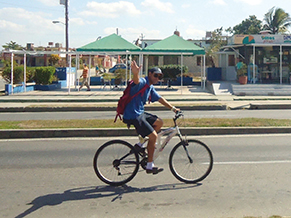
They couldn’t say what they wanted in exchange, exactly. It was as though they couldn’t gauge value in monetary terms, or were unaware of how many different material goods we had aboard. They accepted eyeglasses, soap, razors and fishhooks, but left me thinking they could have used anything.
The last 100 miles to Cienfuegos saw us on a broad reach with 18 knots of wind, moving to beam reach close to mountain breezes. The entrance would have been impossible to miss even without a lighthouse: triple day marks and leading lights to the channel, channel marker, buoys and more day marks. Halfway down the channel we came across Cienfuegos’ famous welcome sign. Only a shadow of ‘Cuba’ peeked between Bienvenidos and Socialista, like a placeholder awaiting the painters’ next move.
A series of well-lit buoys routinely guided oil tankers to Cienfuegos, which we reached in darkness. Two uniformed Guarda Frontera officers dinghied out to show us where to drop the hook in a crowded anchorage. They brought more rules. Show a light at anchor and stow the dinghy on the boat every night. In the background a trumpet solo from a nearby hotel wailed a welcome across the hot Cuban night.
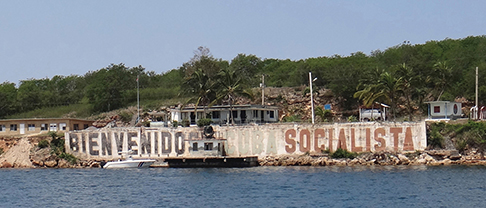
Cienfuegos was an international port, meaning one equipped for full international check-in and-out procedures. We were traveling on a domestic despacho, but officials treated our arrival like an international one. The issue was that when a boat on the south side was out of Cuban officials’ sight for a week or more, they had no real way to know whether it had detoured to Jamaica or Grand Cayman. Thus, contraband—particularly drugs—was always a possibility.
Customs arrived in the morning with a pair of polite Springer Spaniels who sniffed dutifully but fruitlessly. A very young IT guy eagerly read my SSB emails. After they finished, we would all be best friends again, as long as we followed the rules.
Whenever we passed customs on the way to and from visiting friends on the dock, or from the fuel dock, customs was obligated to inspect grocery bags or spare parts or, in case of a crew change, luggage. After being without power for 24 hours, I took my computer ashore to charge it and was questioned by a polite, professional, reasonable officer who then sent me on my way.
With rules, everyone knew where they stood. Dinghies were to be dragged up the beach and tied off to a chain in front of the customs office. Ordinary Cubans could not pass the gate that led to the docks. Officials could recommend (state-run) restaurants and hotels, tell you the actual cost of a collectivo to the Havana airport (15 CUC, but the drivers wouldn’t take a foreigner for less than 20), where to extend a visa and what rules pertained to what vessel, but not a peep about “unofficial” items.
The guards were the guys to ask about eggs, propane and laundry, but they were competing with the jinoteros just outside the marina. Anyone you asked would try to help you, partly because they cared and partly because with profits of 5 or 10 CUC to be made, there was a lot at stake: a week or two’s salary. When I tipped a waitress a bar of baby soap, I thought she was going to kiss me.
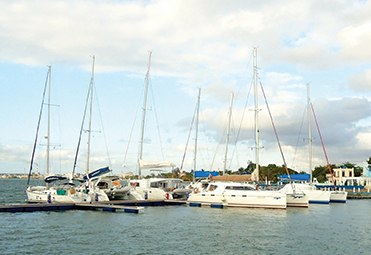
We asked the dockmaster what had happened to the marina dock space. The government was in charge of both Cienfuegos’s marina and charter operations. Charters had tripled in the past two years, he told us. Catamarans that accommodated eight to twelve guests, with or without crew, commanded €2,500 – €5,000 per week, and business was booming.
“We could expand indefinitely,” said the local representative of Platten sailing, a German joint venture.
Alboran from Spain reported the same boom; there was even a French group now. It was clear which was more lucrative; the state had leased or sold most of its space to charter operations.
For the dozen or so boats waiting for a slip, that was bad news. The marina director showed me a newspaper article about the five-year plan for Cienfuegos that included an expanded marina, a hotel and condominiums. When I mentioned the expansion to other employees I got an eye roll or a blank look. You couldn’t get in trouble for a look.
It was a cool 80 degrees when we set off to look for internet again. We had two choices, food or email? No question.
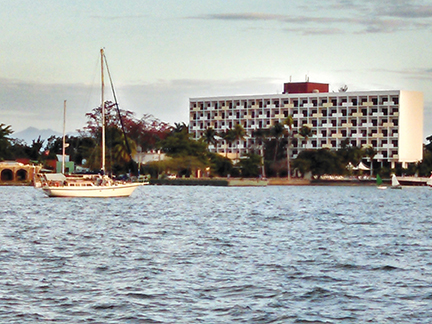
A five-minute walk past a produce stand and a butcher, then a shortcut through a park full of sixties statuary, took us to what guidebooks unfailingly called the “Soviet-style” Hotel Jagua.
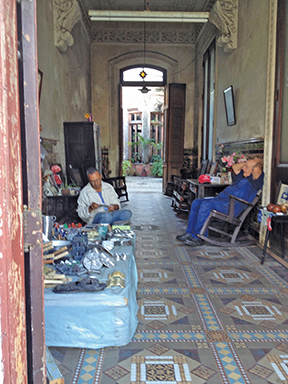
Business was booming there, too. Korean-built buses parked four deep let off tour groups named Smithsonian, Bar Association, Temple Beth-El and Southern Baptist Convention. The hotel had internet but not Wi-Fi; only three old, slow computers. Ay, mi amor, the receptionist said.

They were out of 4.50 CUC cards. Reversing course, we headed down the Prada, alongside pastel columns and mini-parks, toward the architectural mishmash of past and further-past that was Cienfuegos. On the left side of the street, early 19th Century palaces; on the right, El Rapido and fifties bumper cars. Old men playing chess to the left; touts looking for TripAdvisor stars to the right. Outside the Teatro Terry Thomas, where locals gathered after 10 to dance to son and rumba bands, a group of schoolchildren lined up to see a play.
At ETECSA (the phone company) they had internet cards but the power was out. No one knew why. There was a long line. I sighed. ¿Quien es la última?
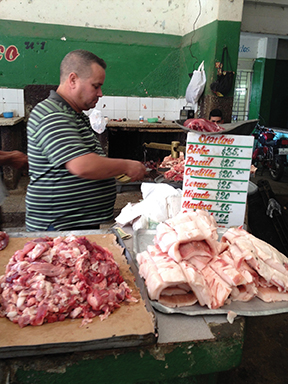
On Tuesday the agropecuario provided relief from already-blazing heat. Concrete blocks balanced dozens of boards where sellers displayed their “extra” produce in neat piles. Congregations of fresh-picked fruit—huge, rosy fruta bomba, guavas, tiny bananas and perfect pineapples—kept company with malanga (taro family), boniato (sweet potato), and those essentials of Cuban sofrito, sweet cachucha peppers (that looked like scalding scotch bonnet) and culantro. Everyday slices of pumpkin and handfuls of dried beans here, freshly shredded coconut there. In one corner, Havana Club bottles held honey, vinegar, and homemade liqueurs. Directly across from it, beef, pork, chicken and rabbit.
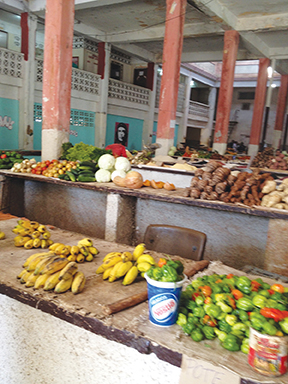 Cubans were selling, not buying. Even rock-bottom prices were too spendy for a $20 per month budget. Sellers didn’t compete with each other over prices, only quality. Bright, tired-looking women brushed stray hair away and explained how to cook the strange vegetables while handsome men kissed their fingers—rico— to show how good the recipe was. They crowded, asking did I like President Obama and wasn’t it great that American tourists would come soon. Looking around the empty market, I thought, Maybe. At least for their sake.
Cubans were selling, not buying. Even rock-bottom prices were too spendy for a $20 per month budget. Sellers didn’t compete with each other over prices, only quality. Bright, tired-looking women brushed stray hair away and explained how to cook the strange vegetables while handsome men kissed their fingers—rico— to show how good the recipe was. They crowded, asking did I like President Obama and wasn’t it great that American tourists would come soon. Looking around the empty market, I thought, Maybe. At least for their sake.
The only item to haggle over was eggs. It was a seller’s market. After we reached an impasse at 5 CUC the vendor asked, “Do you have a Spanish-English diccionario?”
“Maybe.”
“Okay.” He smiled broadly. “I will trade you. After you bring it, eggs for you are only 3 CUC.”
“Deal.” I headed boatward to look for the dictionary.
On the touristy route down a pedestrian-only street, black telephone booths like salon hair dryers waited outside government stores that sometimes sold eggs and always cheap, fine rum. A bici-taxi followed me, offering relief for my sweaty lugging of groceries. I paid him in earbuds instead of cash.

An anonymous person stopped me before I reached my dinghy to ask for a certain broken piece of equipment. I obliged. The next day, I received the yogurt starter I had been looking for. I was getting the context, if not the experience, of life in Cuba. It felt familiar, this reliance on one another. Before I went cruising it was rare; after, something I valued and sought out. No matter what happened next in Cuba, its sense of community was one commodity that I hoped would not be traded away.
This is the second of a three-part, east to west exploration of the south side of Cuba. Christine (and her OFAC license) spent the season exploring Cuba, and blogging as Sissy Puedes in Cruising Compass. Ipaddress She and Stephan Regulinski cruised five years on Delos with their three children. Once they finish paying college tuition, they look forward to cruising again on Hanalei, another Amel SuperMaramu.















